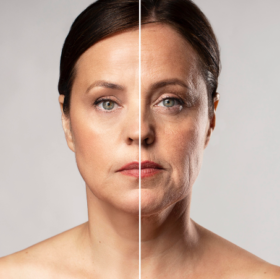 According to the results of a recently published study, there is a correlation between the amount of collagen in mature skin and the microbial composition of the cutaneous microbiota.
According to the results of a recently published study, there is a correlation between the amount of collagen in mature skin and the microbial composition of the cutaneous microbiota.
The skin, a multifunctional organ
This is the most extensive and heaviest organ in the human body, acting as an interface between the internal and external environments.
Made up of three layers (the epidermis, dermis, and hypodermis), it has essential functions such as :
- Sensoriality;
- Synthesis of molecules;
- And a barrier effect.
Healthy skin is elastic, smooth and resistant. However, pollution, UV rays, poor diet and germs can make it more fragile. There is also a genetic responsibility.
With age, the skin loses its elasticity and firmness, becoming thinner as collagen and elastin production diminishes over the years. The result is marked, wrinkled, sagging and uneven skin.
The skin has its own microbiota
Millions of living micro-organisms per square centimetre are housed on the surface of the skin (the epidermis). These make up the cutaneous microbiota.
There are different ecological niches where their number and diversity vary, depending on environmental conditions. For example, the microbial population present on the skin of the hands will be different from that present in the armpits.
This microbiota fulfils many functions that are essential for protecting the body. It:
- Forms a first barrier by limiting the colonisation of pathogenic germs;
- Shapes and modulates the skin’s immune system;
- Influences skin pH through lipid synthesis;
- Regulates epidermal formation, repair, and function.
As with any microbiota, environmental and individual factors, including the physiological changes inherent in skin ageing, can modify it and have an impact on the host.
A clinical trial to understand the link between microbiota and skin ageing
To understand whether skin microbiota is linked to skin ageing, a group of French and American researchers have conducted a two-arm clinical study.
The scientists are aware that gender, ethnic origin, geography, and health condition can affect the composition of the microbiota and represent confounding factors. For this reason, they limited themselves to studying the facial skin of 51 healthy women from Paris:
- 26 young women aged between 20 and 26
- and 25 older women aged between 54 and 60.
They collected biophysical parameters from the volunteers and used a metagenomic sequencing method to characterise all the species and genes in the cutaneous microbiota.
Different microbiota at different ages
The results showed significant differences in the microbial composition of the face as a function of age, but also in terms of antibiotic resistance genes.
Cutibacterium acnes was the dominant bacterial species in all the women, followed by Staphylococcus epidermidis and Corynebacterium kroppenstedtii.
However, young women compared to mature women had:
- A significantly higher proportion of acnes;
- Moderately lower proportions of epidermidis and C. kroppenstedtii,
- Lower alpha diversity.
Alpha diversity is thought to be lower in young women due to the higher dominance of C. acnes, thus reducing the space for the development of other bacterial species.
The researchers then checked whether the difference in diversity observed between the age groups could be attributed to the biophysical parameters . According to them, “ageing reduces collagen production, which could lead to a reduction in the abundance of C. acnes and, consequently, an increase in species diversity”.
They conclude that “the biophysical features of the skin, in particular the diffusion coefficient of collagen, are associated with the composition and functional potential of the cutaneous microbiome”.
LC
References
Picture: Freepik




